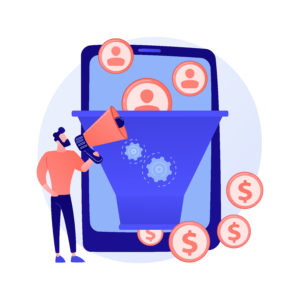Effective selling requires a highly engaged and specific audience. What eCommerce affiliate marketing effectively does is leverage such audiences from third parties: you partner with someone with an impressive following to promote your products and reward them with commission. The more of your product that’s sold, the more money the affiliate earns.
The specifics for how commission is calculated and how products are promoted always vary. Fundamentally, however, affiliate marketing is incredibly low-risk and has the potential to yield a higher ROI than any other marketing technique—including paid social and direct response campaigns.
eCommerce businesses are particularly well-suited to affiliate marketing since it allows them to zero in on hyper-relevant audiences. Even better, since the promotion comes from a trusted source (the affiliate) their likelihood of purchase is much higher.
How does affiliate marketing work?
Affiliate marketing is generally an online strategy. As it usually does, new technology has overcome many of the historical problems with affiliate-style strategies—most notably attribution and tracking exactly which affiliates are generating sales. Now that it’s easy to keep all parties honest, affiliate marketing is more secure than ever.
The affiliate is provided with a personalized buy link to track sales and receive payment. That link includes a parameter with a unique identifier that helps attribute the sale to the affiliate.
Quick basics: what makes affiliate marketing powerful ?
It’s the fact that you branch out and get to present your products in front of new audiences. It can be a very effective way to fuel your sales with relevant leads.
How affiliate marketing benefits all parties
This is the key to the entire affiliate philosophy: everybody benefits. Let’s take a detailed look at the various ways eCommerce firms benefit from affiliate programs, as well as what’s in it for affiliates and end customers.
For the advertiser
- Low costs—Most affiliate marketing happens through larger, interconnected affiliate networks which charge a small fee. There may also be time dedicated to identifying potential affiliate partners; the only other significant costs are commission payments which are factored into pricing.Unlike other advertising models like paid social or Google Search, affiliate marketing is very kind to cash flow with virtually zero ongoing costs.
- Improved SEO—In eCommerce, anything which increases the amount and quality of website traffic is gold dust. Affiliate campaigns deliver this surprisingly well. The more high-value links to your website, the more authority your site has, which affects the long-term standing of your site.More directly, prominent affiliate links can have a ‘halo effect’ wherein more people search for your products online and navigate to your webpages. This can directly increase Google search rankings without any extra costs.
- Hot audience—Usually in marketing we talk about cold and warm leads; affiliates have two major strengths which make leads red hot.First, by partnering with ultra-relevant affiliates, the entire audience is a potential lead with an active interest in your industry, niche, or product type. This level of relevance is almost impossible to attain with traditional advertising.Second, the level of trust between affiliate and audience overcomes multiple objections and increases the likelihood of purchase. There is less “convincing” required because the audience believes they’re seeing relevant, qualified products.
- Reputational boost—If your product becomes associated with a highly-respected affiliate in your niche, this association can work wonders for your reputation and overall brand awareness. Since consumers trust third parties more than the sellers themselves, this can help increase brand awareness and sales.

For the affiliates
The situation is more straightforward for affiliates: they have the chance to earn significant passive income. With a heavily engaged audience, affiliates can simply post ads promoting the product and let the magic happen.
Of course, the most successful affiliates put time and effort into presenting your product as attractively as possible. Since their reward is a direct increase in profit, it’s common for affiliates to carry most of the marketing and awareness burden.
For the customer
Generally speaking, the main benefit to customers is that they’re connecting with desirable products without having to perform excessive research on their own. However, it’s also extremely common for affiliate campaigns to feature discounts and promotions which mean customers get fantastic deals.
Affiliate marketing opportunities for eCommerce
Since the goal is to identify partners who can present your product attractively in front of a qualified audience, affiliate marketing campaigns can be deployed in almost endless ways.
Blogs
Bloggers have been the gold standard of affiliate marketing for years. Renowned for highly-engaged and dedicated audiences, bloggers can sell products more subtly and effectively than virtually any other medium. How do they sell the product? -Easy, they write product reviews and this way can influence a lot the public opinion.
Email marketing
Enormous mailing lists (often directly derived from popular blogs) are another excellent route for affiliates. These audiences are typically used to promotions and highly receptive to relevant offers. Many mailing lists are also contacted several times per day, providing repeated exposure to your offers.
Youtube videos
A staggering 40% of millennials believe that their favorite YouTuber understands them better than their own friends. And if they’re recommended a product that interests them, you can be sure that lofty opinion will carry weight.
Coupons and promotions
The USP of some of the world’s largest affiliate websites is discounts. Platforms like offers.com and Groupon are built around providing the best-value deals on the internet. For short-term cash flow and long-term site authority and reputational growth, discount-based affiliates can be a fantastic solution.

How do affiliate commissions work?
While the generalized view of “payment per sale” is useful, there are actually various ways commission can be structured in affiliate partnerships.
- Payment per sale—The standard approach, also known as CPS (or Cost Per Sale). The eCommerce sets the product price and affiliates earn a percentage of each unit sold. If the affiliate generates a ton of leads but none actually buy using their link, then unfortunately they don’t get paid. (The eCommerce can, however, still benefit)
- Payment per lead (or CPL) —Unsurprisingly, some affiliates are therefore contracted to generate leads, not customers. This can work like a traditional ad campaign: affiliates drive traffic to a landing page with an email form, lead magnet, or similar. The more verified leads, the more they earn.
- Payment per click (or CPC)—The simplest agreement of all is for affiliates to increase web traffic. This is less popular because it doesn’t require a particularly engaged audience or high purchase intent; it just needs volume. Affiliates are paid based on any increased traffic.
How to structure affiliate commission
Looking at the above scenarios, it’s clear that not every affiliate is paid in percentage commission; flat rates are also common.
When approaching affiliates, the first task is making sure your suggested rates are competitive. On average, affiliate percentages lie somewhere between 5% and 30% but there is massive variance between industries, campaigns, and even product lines. Another factor is your own reputation: if you’re new to the industry and want to attract the best-performing affiliates, you might need to offer higher commission.
Over time, the more clout you bring to the negotiating table, the less commission you will need to pay.

Maximize sales by choosing the best-fitting affiliates
It’s all good saying that affiliate marketing can get results for eCommerce businesses—but how do you get the best possible return? First and foremost, you need to find the best partner.
Start by making sure the affiliate’s target audience aligns with your customer base. They should have an active interest in your industry and the types of products or services you’re selling. If your customers are of a typical demographic or from a specific geographic area, make sure the affiliate’s audience is too.
Second, is the affiliate’s following a suitable size? It’s a misconception that affiliate’s need to have massive audiences: the most crucial factor is how aligned their interests are with your products. A small following with a high conversion rate is worth much more than a superstar affiliate with millions of followers…who don’t buy your products.
Another factor with the audience is the quality of engagement. Does the affiliate have strong relationships with its followers? This could be quantified in terms of ratings, views, engagement metrics, open and response rates—just about anything. The more personal the relationship, the better.
Finally, the best affiliate marketers will screen you. You don’t want a partner who will spam their followers with any old product. Instead, look for someone who challenges you to prove why your product is a great fit. Odds are they’ll be more professional, put in more work, and get better results.

Can any eCommerce business benefit from affiliate marketing?
Diversity of application is probably the biggest overall strength of affiliate marketing: anyone who sells products can leverage this tactic. If you look online, affiliates can be found for virtually every industry, market, and product imaginable. All it takes is finding the right affiliates in the right networks, and building effective campaigns.
Affiliate marketing generates 16% of all e-commerce sales in the US and Canada—so even if you’ve never tried it before, we strongly recommend you start testing the water. Affiliate marketers are more like low-cost extensions of your salesforce than anything else.
How to get started with affiliate marketing
The fastest approach is to join an established eCommerce affiliate platform which gives you immediate access to affiliates and makes the process as hands-off as possible. The other option is to search influencers, successful bloggers, YouTubers etc whose audience aligns with your target market. Approach them personally and start the conversation; now that you know how affiliate commissions work and what to look for, you’re ready to start striking deals .
If you want to learn more on the anatomy of an affiliate program, make sure to give this article a read.





